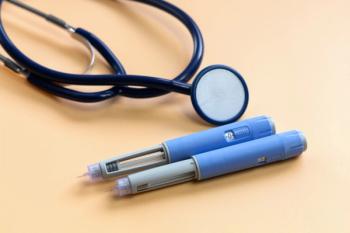
- October 2018 Diabetes
- Volume 84
- Issue 10
There Is an App for That
In spring 2018, the FDA approved the Dexcom G6 CGM System, an integrated continuous glucose monitoring (CGM) system for those with type 1 or type 2 diabetes who are as young as 2 years.
In spring 2018, the FDA approved the Dexcom G6 CGM System, an integrated continuous glucose monitoring (CGM) system for those with type 1 or type 2 diabetes who are as young as 2 years.1
How the G6 System Works
This system consists of an auto applicator, sensor, transmitter, and a display device.2 The auto applicator is applied to the skin of the abdomen, and the sensor is inserted just under the skin. The sensor measures the amount of glucose every 5 minutes while a transmitter, that fits onto the sensor, sends data wirelessly to a receiver or a compatible smart device.1,2
The system allows the user to set personalized thresholds, which fire customized alarms and alerts. If and when glucose levels are either trending up or down as well as out of range, the device will trigger an alarm.1 However, if the alerts and readings from the G6 monitor do not match expectations or symptoms, Dexcom recommends using the results from a glucose meter for diabetes treatment decisions.2
Available only with a prescription, the Dexcom G6 CGM System is transformative in that it does not require fingersticks for calibration or for diabetes management.2,3 With up to 288 readings in a 24-hour period, the system provides better insight into glucose levels and their direction and speed.4
CGM has been proven to lower glycated hemoglobin and decrease the time spent in hypoglycemia, according to the results of a study published in the New England Journal of Medicine.4 The Dexcom G6 System can also be integrated with automated insulin dosing systems, which can autonomously communicate the need for insulin and release it when needed.1
The G6 system builds on older-generation systems and offers new features, such as:3
- Discreet design
- Hypoglycemia predictor
- Longer wear of up to 10 days before replacement of the sensor is needed
- Redesigned sensor applicator, which allows for 1-touch simple insertion
- Water-resistant sensor and transmitter (may be submerged under 8 feet of water for up to 24 hours)
Another feature of the G6 is the acetaminophen-blocking feature, which minimizes interference from acetaminophen and, in turn, provides more accurate glucose readings if and when acetaminophen is taken.5 In previous versions G4 and G5, fingersticks were required to determine glucose levels with the ingestion of acetaminophen-containing products. This is because acetaminophen interference resulted in falsely elevated glucose readings.5 With the newer version, users can safely take 1000 mg of acetaminophen every 6 hours and not have to worry about the medication interfering with their glucose readings. However, taking more than 4000 mg in a 24-hour period can lead to falsely elevated readings.5
Important Safety Information
There are some possible risks associated with the use of this system. Patients may experience redness or skin irritation where the adhesive patch is applied. In the case where the hardware or set-up issues prevent the alarms and alerts from firing or if inaccurate information, given by the G6 system, is used to make treatment decisions, there is a risk for hyperglycemia or hypoglycemia.1
To ensure proper and safe use of the device, as well as accurate glucose readings, following the instructions is critical. This includes, but is not limited to, the instructions for calibration, insertion, inspection, troubleshooting, and use with the available mobile applications, which can all be found on the manufacturer’s website. Given the internet connection, users can track and visualize glucose levels on a compatible device via the Dexcom G6 App. Compatible with both Android and Apple smart devices, the system transmits information every 5 minutes. The app also enables the sharing of the data with caregivers or loved ones. Furthermore, a separate app, the Dexcom Follow App, provides the capability to remotely share glucose data with up to 5 individuals.6
Patients can easily track glucose levels and identify patterns and trends over time with specialized software, Dexcom CLARITY. The data provided can be downloaded, printed, and sent to the provider before an appointment.2,6
Two clinical trials, including 320 adults and children with diabetes, compared the data obtained from the Dexcom G6 with glucose levels obtained from a lab over the course of 10 days. No adverse effects were reported, according to the FDA.1,7
Anyssa Garza, PharmD, BCMAS, is the vice president of content and patient education programs at Digital Pharmacist and an adjunct assistant professor at The University of Texas at Austin College of Pharmacy.
References
- FDA authorizes first fully interoperable continuous glucose monitoring system, streamlines review pathway for similar devices [news release]. Silver Spring, MD: FDA; March 27, 2018. www.fda.gov/newsevents/newsroom/pressannouncements/ucm602870.htm. Accessed August 1, 2018.
- Dexcom. Dexcom website. dexcom.com/g6-cgm-system. Accessed August 1, 2018. ​
- FDA authorizes marketing of the new Dexcom G6 CGM eliminating the need for fingerstick blood testing for people with diabetes [news release]. San Diego, CA: Dexcom; March 27, 2018. dexcom.com/news/fda-authorizes-dexcom-g6. Published Accessed August 1, 2018.
- Dexcom. What is (CGM) continuous glucose monitoring? Dexcom website dexcom.com/continuous-glucose-monitoring. Accessed August 7, 2018.
- Dexcom. Safety information. Dexcom website. dexcom.com/safety-information#dexcom-g6-brief. Accessed August 3, 2018.
- Dexcom. Discover the Dexcom G6 CGM System. Dexcom website. dexcom.com/products. Accessed August 3, 2018.
- Voelker R. Blood glucose readings made possible via smartphone. JAMA. 2018;319(17):1758. doi: 10.1001/jama.2018.4928.
Articles in this issue
about 7 years ago
Make a Point of Preventing Insulin Pen Errorsabout 7 years ago
Obesity Is a Weight-Loss Maintenance Problemabout 7 years ago
Valproic Acid and Carbapenem Antibiotics Interactionabout 7 years ago
Saturated Fat and Cardiovascular Diseaseabout 7 years ago
An Unsafe Practice: Reuse of Prefilled Saline Flushabout 7 years ago
Nonprescription Products for Proper Diabetic Foot Careabout 7 years ago
Provision of Diabetes Sick-Day Plans in the Community Pharmacyabout 7 years ago
Kentucky Bans Pharmacy Gag Clausesabout 7 years ago
Handling Prior Authorization Requests: Revisited on AppealNewsletter
Stay informed on drug updates, treatment guidelines, and pharmacy practice trends—subscribe to Pharmacy Times for weekly clinical insights.


















































































































































































































